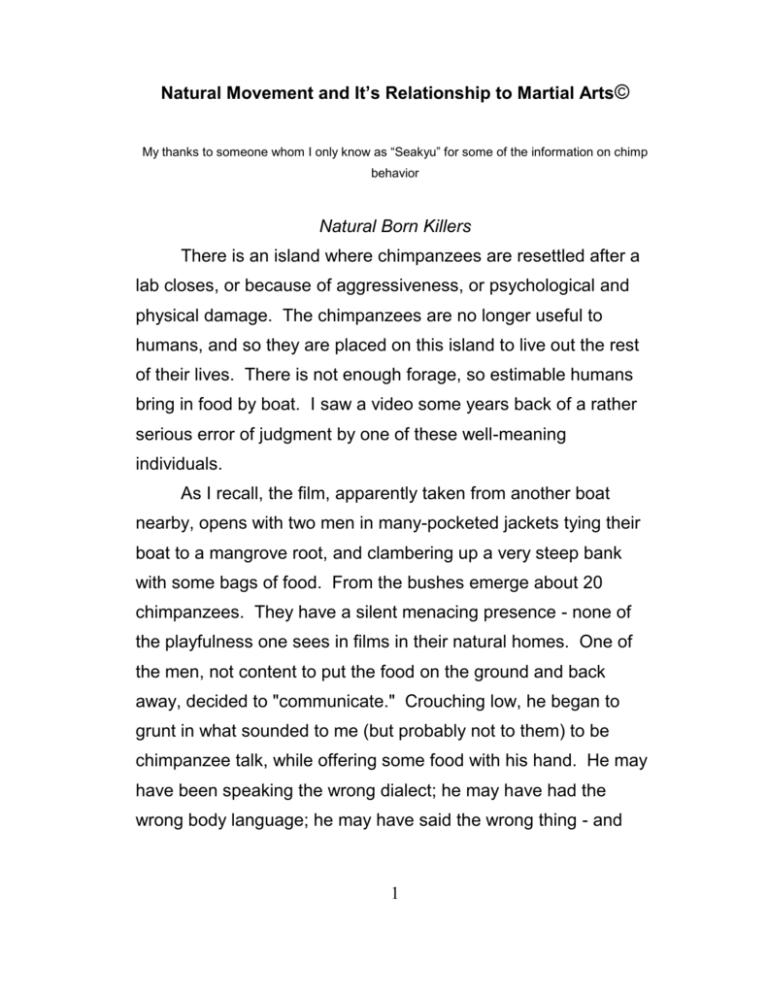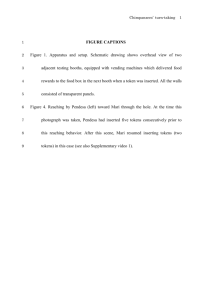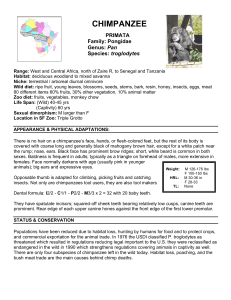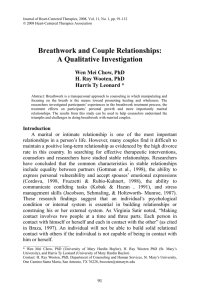NATURAL
advertisement

Natural Movement and It’s Relationship to Martial Arts© My thanks to someone whom I only know as “Seakyu” for some of the information on chimp behavior Natural Born Killers There is an island where chimpanzees are resettled after a lab closes, or because of aggressiveness, or psychological and physical damage. The chimpanzees are no longer useful to humans, and so they are placed on this island to live out the rest of their lives. There is not enough forage, so estimable humans bring in food by boat. I saw a video some years back of a rather serious error of judgment by one of these well-meaning individuals. As I recall, the film, apparently taken from another boat nearby, opens with two men in many-pocketed jackets tying their boat to a mangrove root, and clambering up a very steep bank with some bags of food. From the bushes emerge about 20 chimpanzees. They have a silent menacing presence - none of the playfulness one sees in films in their natural homes. One of the men, not content to put the food on the ground and back away, decided to "communicate." Crouching low, he began to grunt in what sounded to me (but probably not to them) to be chimpanzee talk, while offering some food with his hand. He may have been speaking the wrong dialect; he may have had the wrong body language; he may have said the wrong thing - and 1 remember, the chimpanzees in question had been imprisoned and tortured by humans for years - but they were apparently not in the mood to make distinctions between "good" humans and "bad." A large male suddenly LEAPT at least ten feet through the air, landed on the man's shoulders and clutched him with his feet. He began flailing his massive arms in windmilling open-handed strikes - and at the end of each strike, he'd grab and yank flesh and clothes. The man began rolling and crawling, trying to get away, but the chimp rode him like a surfer, and grabbing one of the man's upraised arms, shoved his hand in his mouth and bit off at least one finger. The victim continued to stagger away, and as he stumbled down the steep bank into the water, the chimp jumped lightly off, stood on the edge of the bank and stared at the two humans scrambling back into their boat. Chimpanzees share about ninety-eight percent of our DNA. They are so close to us on a genetic level that many scientists have reclassified them as belonging to the genus homo, the same as us. They are so close, yet so far. As knuckle-walkers, their arms are at least a foot longer than ours, and this, with their tendons attached much deeper and more solidly into the shoulder, makes them immensely strong. A cousin of mine, who used to work in a circus observed an informal experiment where an adult male chimp was taught to lift weights. They kept adding weight, rewarding him with food every time he lifted the barbell above his head. He got bored, however, at 600 pounds, and threw the weight across the room. 2 Chimpanzee social hierarchy is established by physical dominance - whenever the hierarchy is not established, one or another chimp will launch into dominant behavior - violent attack – with little or no provocation. The facial expression that is a smile in a human is perceived as very aggressive by a chimp and therefore, my cousin, a clown in the circus, told me that the clowns in make-up had to hide their faces when passing near the chimps, or they would be attacked. Chimpanzees live at what we would view at the lowest level of human interaction. Although they can be profoundly tender – dare I say loving – to one another, they work out conflicts through pure violence. From the moment chimpanzees are adolescent, they will test each and every individual with whom they come into contact, and blood is almost always shed. In chimpanzee world, the only one who doesn’t get seriously hurt is the winner – there is no permanent state of peace. They fight with flailing overhand blows, and very deliberately targeting “projecting” areas of the body, trying to bite off fingers, toes and genitals, and when attacking humans, noses and ears as well. Gorillas are less aggressive by nature, particularly the females. They are simply more mellow and laid back. More important, perhaps, is that once absolute dominance is established by a silverback male, there is no place for a competitor, and so other males either keep their distance or are subservient. The males only fight when a dominance display no 3 longer works, and the younger male sees a chance to take over. In any event, gorillas fight too. I've seen a film of two female gorillas fighting: like attacking chimps, they flail with openhanded strikes, both of them urinating in fear/rage as they exchanged blows. I've frequently seen toddlers fighting – once again, open, over-hand flailing strikes, (in most cases, simultaneously trying to pull their own faces as far away as possible), accompanied by scratching, grabbing, and biting. When we humans are functioning using the more primitive areas of the brain, activated in situations where the organism perceives itself – rightly or wrongly – to be at absolute risk, we fight like chimps. Adults who have so regressed because of mental illness, drug intoxication, or pure unadulterated rage are very hard to control without a lot of people, a Taser ®, or other mechanical means. There is No Such Thing as an Unnatural Act “Natural” is one of those very BIG words which can mean almost anything. Beyond the most basic and primitive reflexes, however, the actions of human beings are far more than reflex arcs in the brainstem. Is “natural movement” only what is instinctive, like the oozing of a protozoa? If so, it would follow that trained movement is “unnatural.” However, one can also take the point of view that any movement is natural when performed by a 4 natural, living being - trained movement no less so than instinctive movement. Life-threatening conflict – or conflict which, because of one’s psychological make-up leads one to perceive one’s being as threatened - evokes panic, a primitive rage-terror that the ancient Greeks symbolized by the god Pan. (Interestingly, the old genus/species name of chimpanzees was pan troglodytes.) When anyone, even a trained professional fighter, is in panic, one tends to grab and/or flail in downwards strikes, whether armed or unarmed. According to David Grossman, in his book, On Killing, soldiers in bayonet charges often “instinctively” reversed the weapon and use the shoulder stock as a club, ignoring the bayonet entirely. The human brain – and hence the human organism – can acquire skill in activities that are not specifically hard-wired at birth. Piano playing, tight-rope walking, tying a knot in a cherry stem with one’s tongue – all of these require practice, and very likely, instruction. What makes the incredible panoply of human activity possible is a something called neuroplasticity. Contrary to what was long thought, the nervous system is mutable. Whenever an action is repeated often enough, the brain changes structure to make the activity more efficient. This includes creating new interconnections between nerves and also the growth of new neurons. Let’s say I practice a complex set of movements – ie., a sliding step on a diagonal, coupled with a push off the ground with the back foot, an abrupt stopping of the 5 motion with the front foot, a twisting of the torso while exhaling with the stomach muscles drawing in, a tightening of the perineum, all with a sudden explosive shout through a half tightened throat, the eyes wide open, the left hand brushing off an incoming blow which the right fist is thrust in the opponent’s solar plexus. As I practice this movement over and over again, I will become more skillful. A large part of this “skill” is enervation of the musculature. This is a process that we carry out throughout our lives. The expert is thus “wired” for the skill – and functions in what could be termed a “pseudo-instinctual” level. He or she has a movement or other set of actions so engrained that it is as if they were “born that way.” Skill is often the superseding of primitive reflexes by trained response, controlled and mediated by the neo-cortex or human brain. Rather than a “higher” brain over-ruling a lower brain, the neo-cortex controls and mediates all brain functions. Primitive regression, however – road-rage, for example, where the driver, like a chimp whose alpha status is threatened, loses all sense of future consequences in his or her drive to regain a perceived loss of position within the pack – is a superseding of higher/coordinated functioning back to a more instinctive level. The trained fighter is someone whose retraining of the nervous system extends deep into the more primitive areas of the nervous system. Adrenaline no longer activates chaotic or panicked response – instead, it is the “on-switch” for a calm, 6 exquisitely focused state, functioning at tremendous speed and power. Internal Skill – The Flow of Nature There is a subset of skills within martial arts known as “internal skills.” Perhaps some of these skills are manifest when one taps into a life-energy, qi – which are be directed and focused like a subtle etheric fluid. Perhaps the expression of such skills is merely the result of a very complex integration of muscles, tendons, fascia, and nervous system. Although called “natural” in some circles, skill acquisition requires thousands of hours of training in very specific methods of breathing, meditation, or stance training, to name only a few of the methods. Internal skills are typified by abilities that, at times, seem uncanny or superhuman: the ability to absorb, without movement, an attacker’s fully body weight smashed into one in a charge; knocking someone over without apparent movement, with only a light touch; redirecting of forces so that one, like a snake twining around tree limbs in a windstorm, maintains coordination against constantly changing forces. Internal skills are quite hard to explain – there are debates whether all such skills are permutations of one basic set of criteria, like different electromagnetic waves. Others claim that we are talking about training the human body to direct and control various types of psycho/physical energy and that the internal skills of an expert in one discipline are intrinsically different from those of another. 7 The roots of such rarified skills are mundane, however, of this world rather than bequeathed from Heaven. Consider an Inuit hunter, required to stand motionless beside a seal hole for hours, because the slightest movement would scare the seal away. He will learn to stand with efficient relaxation, ready to move instantly despite hours of immobility in the cold air. Consider a forest hunter, who, shooting a monkey with a dart, must run through the jungle, tracking the monkey as it escapes in the treetops, the poison slowly working its way through the animal’s system, the hunter slipping and ducking through the trees, avoiding stones and sharp objects with his bare feet, as graceful as an Alvin Ailey dancer, as balanced in full flight as the Inuit is in stillness. In almost all human cultures, skills such as these were transferred to another activity related to, but distinct from hunting – warfare. The best (surviving) warriors permutated and elaborated aspects of the skills require to hunt so that they could deal with prey which could fight back. A “natural” life is a powerful life – one is using one’s body at all times, responding to challenges every day, because to fail is to die – the human organism is required to act with everything he or she has. The power and endurance that so-called primitive people display can be amazing. The same is true with those who still labor to survive: carrying heavy loads, or building structures with little more than one’s body and simple tools, or such repetitive acts as milking one hundred cows by hand, 8 pulling up one hundred rows of carrots, or laying thousands of bricks in a single day. Anyone who has to do hard physical labor, particularly when bearing heavy loads, begins to develop the ability to channel outside forces through one’s body into the ground, and conversely, using the ground to “brace” so that one can push and pull with all one’s power, no iota dissipating tangential to this alignment. As humans, however, we have always perceived “more” within the world than what is in front of our eyes. How can we explain the terrors of the night, the mysteries of birth and death, or the animating force of life itself, without “supernatural” being? Given that such terrible forces seem to exist, we must deal with them. Most cultures designated experts – shaman - who contacted such forces and mediated with them on behalf of the tribe. One of the ways this has always been done is psychoactive substances. Perhaps the most powerful psychoactive chemical is DMT (N, N-dimethyltryptamine), a substance contained in a number of otherwise unrelated plants, which induces visions, apparent telepathic experiences, soul travel and contact with powerful entities (gods) from beyond the mundane world. DMT is a substance naturally occurring within the human body, located in the pineal body of the brain.1 It is apparently released only when the entire physical organism is stressed: during childbirth, death, starvation, extreme fatigue, or 1 Strassman, Rick, DMT: The Spirit Molecule, Park Street Press, Rochester, Vermont, 2001 9 extreme emotional distress – or possibly deep meditative experiences. Shaman, therefore, developed a “technology of actions” – controlled starvation, physical mortification, drumming at certain rhythms, hypnosis, for example - to stress the organism sufficiently to induce visions – in essence, to release this chemical from within one’s own body. Among the more powerful techniques is breathwork – patterns of breathing that evoke psychological and spiritual experience. The shaman was not divorced from the tribe, unlike priests can be from their community – and many of these breathing methods were surely derived from methods necessary to run long distances, to remain quiet in danger, to endure cold while soaked through to the skin, to calm oneself while under attack, or to gather enough power to carry a several hundred pound animal home from miles away. Such breathing methods were refined into incantations and spells and these into prayers. As warriors and shamans continued to study an integration of physical skills and breathwork, thereby intertwining methods of physical survival and spiritual harmony with the gods, people noticed subsidiary benefits: some of these practices improved health, made one stronger, and even enabled one to do rather extraordinary things. Just as the single string bow-gourd evolved into the 12 string guitar and the even more complex and sophisticated sitar, so human beings, given thousands of years and millions of predecessors, developed incredibly sophisticated 10 ways to use their bodies. Returning to the concept of neuroplasticity, humanity has another remarkable capacity. One’s nervous system grows along patterns one imagines. Simply lying or sitting quietly, one can recall the movements of an expert, or imagine oneself doing a perfect act, and the nervous system will, to some degree, enervate the muscles most appropriate to accomplish this task. Imagine, then, a man: he is very strong, and as a game, friends try to push him over. Few, if any can. He finds that as he breaths a certain way, his stance is even stronger. When he practices various stances now integrated with breath, his power flourishes. Furthermore, when he recalls how successful he was when he stood in a certain position with certain muscles tense and others relaxed, he gets better and better. He imagines victory over and over, the sequence from start to finish running like a vision on the “screen” of his closed eyelids. Soon, his skills are so great that he, as one man was described to me, can stand at the edge of a porch, gripping it with just his toes and allow others to crash into him. Rather than falling backwards, they bounce off, one after another. The internal martial arts have made a specialty of such training, a combination of breathwork, stance practice, and guided imagery, all coordinated with very specific physical movements. 11 Let us consider xingyi ch’uan (lit. “form directed by will”), a Chinese combative art that specializes in the explosive application of force at very close range. This martial art requires the repetitive practice of five core movements that allegedly express the structure of the universe in the Taoist schema of five basic elements. Xingyi is claimed to embody the “natural” flow and permutation of energy in the cosmos. Technically, while xingyi looks like trapping, deflection, redirection of force, AND explosive, short-range attacks, what makes xingyi so powerful is the ability to exert an astonishingly powerful amount of force with no wind-up – as long as you can touch him, you can level him. This ability is the product of systematic practice including long periods of standing – immobile – rebooting the organization of the body, so to speak, by standing in the same kind of active relaxation that the Inuit hunter must have maintained while poised with spear in ready position over a breathing hole in the ice. Why is standing still so valuable? If you move, you take the stress off the nervous system and the body, and simply continue to compensate in a way that you are used to. But if you practice “not-moving” long enough, the brain gets the information that it is going to have to deal with the fact that this body will stay in this position, like it or not. The result is that the brain begins to reorganize to make the posture less stressful, and hence begins to enervate the muscles differently to aid in maximum efficiency. Almost all so-called internal arts either practice include standing practice, or use simple repetitive movements, through which one 12 achieves similar results, in essence achieving “immobility within motion.” 13










